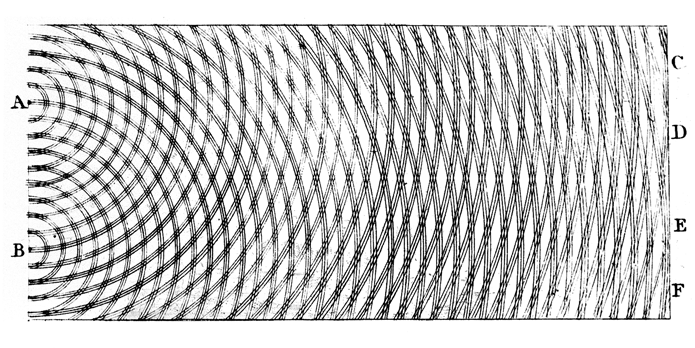
Source
The most famous early experiment regarding the nature of light was Young's interference experiment.
At the time of Young's experiment, there was uncertainty in the scientific community regarding the nature of light. Young, having worked on sound before turning to work on light, thought that light was a wave. On the other side of the debate, many well respected scientists backed the particle nature of light. These scientists included Newton, who needless to say, was extremely well respected in the scientific community.
Despite this, Young wanted to prove the wave nature of light[1]. To this end, he designed and performed an experiment in 1803 to determine the nature of light
Young's experiment was based on the idea that waves create interference patterns when they collide with other waves. This occurs because the amplitude of a wave colliding with another wave is equal to the sum of the amplitude at that point. If light was a wave, that means that if there was two wave patterns interfering with each other, then there should be stripes shown on the surface that the waves are projected onto. Below is Young's prediction what the interference pattern would look like if light was a wave.
As you can see, the goal was to generate two wave patterns that would interfere with each other. To this end, Young designed a plate with 2 slits to let light pass. This would create the interference pattern that was necessary for the experiment.
The basic design of the experiment was simple. In a dark room, shine a light source through a plate with 2 slits, and have a surface behind to capture the light. The image below shows the experiment as it would be set up with modern equipment.
This experiment produced the expected interference pattern, providing evidence in favor of the wave nature of light.
The results of this experiment, along with some work from Huygens, were combined into a more general theory by Fresnel. This theory manged to convince many people in the scientific community, but there remained a community of die hard particle theorists. One of these theorists, Poisson, claimed one of the implications of Fresnel's theory should be that there would be a dot in the center of a shadow cast by a disk. Furthermore, he claimed that nobody had observed this spot, and so therefore, the theory was bunk. In response to this claim, an experiment was carried out that actually found the claimed spot. With the discovery of this spot, sometimes called the Poisson spot, the matter was fully settled for the time being. The wave theorists had proved their claims.